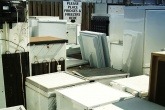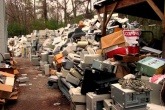WEEE exports under the spotlight on International E-waste Day

Participating organisations will be carrying out a number of initiatives – from conferences, school and city collections and promotions in stores and recycling centres, to infographics, videos and animations – to inform consumers about the impact of e-waste and how to dispose of items correctly.
WEEE is one of the world’s most damaging and least recycled waste streams. Across the planet, an estimated 50 million tonnes of e-waste will be generated in 2019 and currently only 20 per cent of that is recycled each year. Despite two thirds of the world’s population being covered by e-waste legislation, 40 million tonnes per annum either goes to landfill or is burned or illegally traded and treated in a sub-standard way.
Not only does the incorrect disposal of WEEE result in the loss of valuable and critical raw materials (such as rare earth elements) from the supply chain in developed countries, but the illegal shipment of waste to developing countries has a detrimental impact on the countries and workers receiving the imports, causing both environmental and health issues.
Though shipping e-waste to developing countries is banned, 1.3 million tonnes of undocumented WEEE is estimated to be exported from the EU every year. This is often incorrectly classed as ‘used’ or ‘second hand’ and still ends up being dumped.
China was the main destination for the UK’s waste until January 2018, when the Chinese Government imposed bans and restrictions on a range of solid wastes being imported including plastic and e-waste. Now, much of the UK’s exports are sent to countries such as Nigeria, Pakistan and Ghana where regulations are less strict and WEEE often slips through as ‘second hand’ because there is insufficient testing done to see if the items actually work.
The recycling process for e-waste can be dangerous, with WEEE containing up to 60 different metals and chemicals that are hazardous to the environment and to human health if disposed of incorrectly.
UK e-waste targets
The UK is one of the worst offenders in the exportation of e-waste and has been consistently falling behind on its WEEE recycling targets, with the most recent figures (released in September) indicating the country is at risk of missing out on its annual targets for the third consecutive year in a row.
Up to half of the WEEE produced is made up of personal devices such as computers, screens, smartphones, tablets and TVs, with the remainder being larger household appliances and heating and cooling equipment.
A report from the Royal Society of Chemistry conducted in January 2019 suggested that 45 per cent of UK residents surveyed have up to five unused electronic devices in their home and 82 per cent of these said they have no plans to recycle or sell on their devices – most will end up in landfill at some point. Partly, this is down to fears about data and security, but a lack of knowledge on how to dispose of e-waste correctly is also a big factor – almost a third of people surveyed said they didn’t know where to go to recycle their old tech.
Commenting on plans for this year’s International E-waste Day, Mark Burrows-Smith, CEO of WEEE producer compliance scheme company, REPIC, commented: “One of the biggest challenges the UK now faces in its WEEE management strategy is setting more realistic collection targets.”
“The difficulty lies in predicting future purchasing habits and estimating the e-waste that will be generated from it. In the UK, there’s a fractured WEEE dataset, and it’s difficult to determine what happens to electrical goods that are not reported through Producer Compliance Schemes.”
“To raise awareness of this issue, we recently issued a report entitled ‘Understanding WEEE and EEE flows’ to support implementation of policy objectives’ and to support international e-waste day we’ll be sharing key facts, statistics and infographics from the report on our social media channels throughout the day.”
International E-waste Day has been organised by the WEEE Forum, which has developed a series of infographics to illustrate the growing e-waste problem, as well as videos featuring different representatives from the e-waste value chain giving their take on how to tackle the challenge.
The WEEE Forum’s Director General, Pascal Leroy said: “From 2019, the minimum collection rate to be achieved annually in EU member states will be 65 per cent of the average weight of appliances placed on the market in the three preceding years, or alternatively 85 per cent of WEEE generated.”
“The new collection targets seek to ensure that around 10 million tonnes, or roughly 20 kilogrammes per capita, will be separately collected. Such a high collection rate is impossible to reach without the involvement of all actors in the value chain, including citizens.”
“We are confident that International E-Waste Day will contribute to improving the societal awareness and through this help in improving the collection rates not only in Europe, but also globally.”







